Linking Women’s Economic Empowerment and Tackling Hunger
Hunger and Gender Equality from the Perspective of Indian Women
Unleashing women’s potential makes a significant contribution to the food security and well-being of their families.
Millennium Development Goals (MDGs)
Goal 1 Eradicate Extreme Poverty and Hunger
Goal 2 Achieve Universal Primary Education
Goal 3 Promote Gender Equality and Empower Women
Goal 4 Reduce Child Mortality
Goal 5 Improve Maternal Health
Goal 6 Combat HIV/AIDS, Malaria, and Other Diseases
Goal 7 Ensure Environmental Sustainability
Goal 8 Develop a Global Partnership for Development
"We have changed our mindset"
In many countries, hunger is linked to the unequal treatment of the sexes. The example of Sarwan, a village in India where the aid organisation Welthungerhilfe has been active since 2005, illustrates this assertion vividly. Sarwan is one of 15 Millenniumsdörfer supported by Welthungerhilfe whose population is striving to achieve one or several Millennium Development Goals by the year 2010 (see box right on MDGs).
The villagers themselves decide which goals are to be prioritised in their villages. Developments on the ground are observed by means of household surveys and are discussed in workshops with selected representatives of various groups in the village on an annual basis. This monitoring of Millennium Development Goals scrutinises progress and problems in two ways: by collecting data, for example changes in household incomes or girls’ school enrolment rates, and by the village communities assessing their development steps to date on a scale from “excellent” to “very poor” (see figure below: Villagers’ perspective on achievement of development goals).
In this way, the people concerned remind themselves time and again how and why their living conditions are changing. This form of consciousness-raising not only enables village communities to adapt priorities to current needs, but also makes it possible to improve project measures, an approach fully in line with the goal of helping people help themselves.
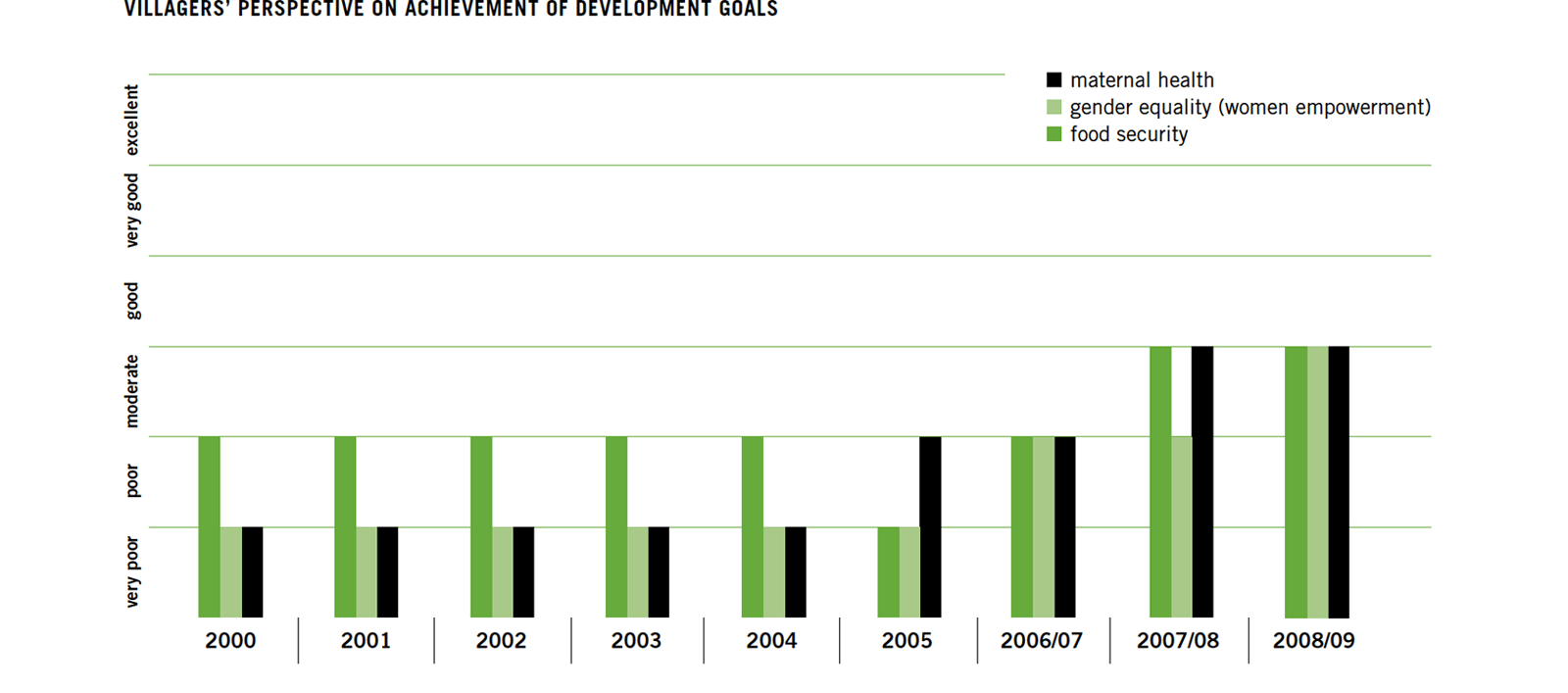
Note: Development Goals relating to MDG-Monitoring: Food Security: Improved health conditions and affordable health services, Dependence on rainfed agriculture, Seasonality of Rainfall. Gender Equality: Equal access to education for boys and girls, Equal work load for men and women, Increased role of women in taking decisions in Gram Sabha. Maternal Health: Increased nutrition for pregnant mothers, Full utilization of Governmental hospital and medicines, Access to safe drinking water.
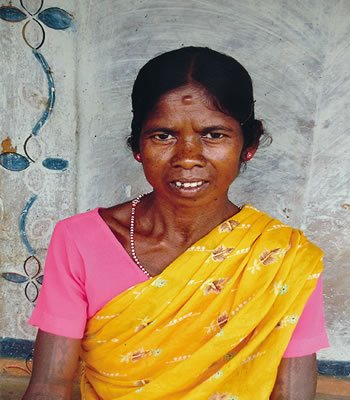
Betiya Soren,
Informally working mother, Sarwan
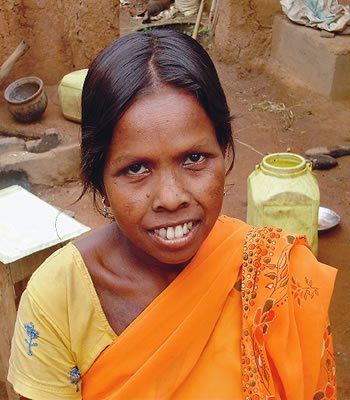
Anita Hembram,
Informally working mother, Sarwan
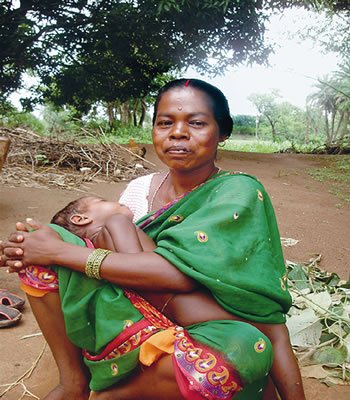
Sonamuni Murmu,
Informally working mother, Sarwan
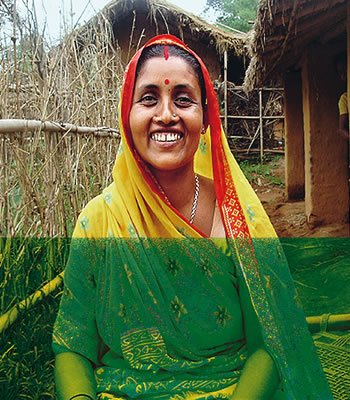
Gita Devi,
Informally working mother, Sarwan
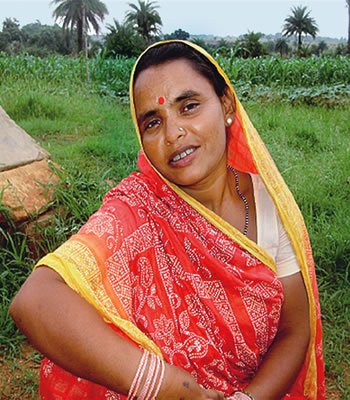
Birma Devi,
Informally working mother, Sarwan
These data and assessments also permit insights into the linkage between hunger and the lack of equal rights. The local people’s perspectives are crucial here: it is clear that improving the position of women in society plays an important role in increasing food security.
Food security exists when all people, at all times, have physical and economic access to sufficient, safe, and nutritious food to meet their dietary needs and food preferences for an active and healthy life (FAO, World Food Summit, 1996). In rural India, women play a central role at these levels of food security – availability, access, and utilisation.
Gender Equality Supports Food Availability at the Household Level
In rural areas of the Indian state of Jharkhand (India State Hunger Index 1 score: 28.67; severity of hunger: alarming), about half of all men and women work on small family farms; 41% of women and 27% of men work as agricultural labourers. Many agricultural tasks that even a few years ago were the responsibility of men are now taken on by women because men are switching to better-paid wage labour. This “feminisation of agriculture” can be observed across India.
Policy-making is slow to take this development into account, though, and support for women in agriculture is accordingly being granted only hesitantly. Experiences and studies suggest, however, that equal access to education and agricultural resources can increase productivity by ten to 20% (see page 22). This aspect plays an important role in the Millenniumsdorf of Sarwan: women receive support and training to improve agricultural cultivation methods. In addition, they have the option to purchase better seed and equipment, for example, via self-help credit groups.
Betiya Soren from Sarwan learned in a group setting how to use her land more efficiently:
Very recently we also got some irrigation facilities and learned about improving farming through our group meetings. We are growing vegetables on our homestead and using them for our daily consumption.
Anita Hembram in turn is not only growing more vegetables for her family’s consumption, but is also increasing her income:
We women were working as agricultural labourers, but different meetings held in the village have changed our mindset. I was not growing anything near my homestead land, but last year I started to produce some vegetables for us to have in our food. I also sell them on the local market if we have extra production. This also has given me some income occasionally.
Yet the societal status of women does not improve automatically when they take on a more important role in agricultural production. On the contrary, there is the risk that their standard of living is not raised decisively but that their workload increases when they must perform additional tasks. In order to improve their income and food situation, it is therefore crucial that women obtain access to resources, that is, to credit, land, and agricultural means of production.
Sonamuni Murmu experienced how important it is to be able to take on responsibility:
My husband used to earn money for the family and I was involved in domestic work most of the time. But now I spend my time in my own field. My husband helps send the children to school and sometimes also with the housework. I could not take any decisions and I had to accept whatever my husband wished. But now we both decide what we should do for our family. Now we are both thinking together about increasing our farming towards strengthening our livelihood.
To date, women have seldom owned land. But more important than land ownership is the question of whether women have control over what they harvest. Only then can the income women earn in agriculture support them in making their own decisions at home. Besides these economic aspects, the organization of women in self-help groups outside their own families is of particular major importance. The groups provide them with the space they need for discussions and the experience of learning new things. Gita Devi speaks about how helpful self-help groups are:
I feel self-help groups are the best work done by the organisation, and they are important for the empowerment of women. We discuss the rights of women and they give us so many ideas. We are also learning how to work together in group activities.
In this way, equal access to knowledge and resources can contribute to increasing households’ food security. If women are mobilised in form of training, information sessions etc. at village level, their roles in the community can be transformed. Once this process has been set in motion, it can develop its own dynamics: women’s increased self-confidence generates economic innovation power, which in turn contributes to increasing food security.
The positive effects of the measures described – continuing education in methods of agricultural cultivation and establishment of a microcredit system for women, among others – can be supported or constrained by outside influences, in India especially by the negative effects of cultural or traditional norms relating to women. At the same time, the National Rural Employment Guarantee Act, passed by the Indian government in 2005, is helpful. It can create new employment opportunities especially for women in rural areas. Equal pay for equal work is mandated by law and is put into practice by government employers as well as non-governmental organisations. Various educational programmes outside of the project are working towards realising gender justice. Birma Devi emphasises:
But earlier we were told that girls can’t do anything except work in the kitchen. Hence our male counterparts used to enforce their decisions about girls’ education. Now, due to different government and other developmental programmes such as the Millenniumsdorf Sarwan initiative, the situation is changing, resulting in male members of our society starting to cooperate with us on girls’ education. We are sending our girls to school.
MDG Monitoring
The monitoring programme for the 15 Millenniumsdörfer managed by Welthungerhilfe has a quantitative and a qualitative aspect.
Questionnaires are used once a year to collect data in the villages for quantitative monitoring. The survey includes most of the 48 indicators used officially by the United Nations to monitor the Millennium Development Goals. For example, one indicator for the goal “ensure environmental sustainability” (MDG 7) is the fraction of people with access to clean drinking water.
There are also questions about income, child mortality rates and school enrolment rates. The standardised results make it possible to measure changes in each Millenniumsdorf as well as make comparisons of development in different villages.
In the qualitative part, a workshop – “Participatory Impact Assessment” – is held annually with a representative crosssection of the village population. Every social group is represented, including officials, youths, women, farmers, and representatives of poor families. The participants determine step by step which changes in the village community they want to use to measure the Millennium Development Goals. The discussion follows nine key topics, based on the eight UN Millennium Development Goals: poverty, hunger, education, gender equality, child mortality, maternal mortality, severe illnesses, environment and natural resources, and external conditions for development. For each key topic, the participants define three development goals relevant to the village that they would like to attain in five years. For example, for the key topic hunger, the goals might include sufficient access to seed or the availability of draught animals for working the fields. In addition, they take stock of how progress in achieving the goals is linked to measures in Welthungerhilfe’s projects in the Millenniumsdörfer. For example, this makes it possible to observe how the construction of a well affects the attainment of individual Millennium Goals.
Equal Rights for Women Improve the Utilization of Food
Even if enough food is available within a family, this says nothing about whether all family members can access an appropriate diet. In India, for example, the traditional custom is that women eat only when all other family members have eaten their fill. If food is scarce, it means that hardly anything is left for women. In other words, the availability of food by no means guarantees that women have appropriate access to it. Sonamuni Murmu suffered because of this tradition for a long time:
A few years back, I used to put my cooking pot over the oven and waited. If my husband brought something, I would cook it. I did not have three full meals and I used to eat what my children left.
A poor diet can also be the result of a lack of knowledge and insufficient education. This affects men just as it does women. In the Indian context, however, the woman is considered the key person for her family’s diet. Traditionally, she is the person responsible for the task of preparing food. This is how Gita Devi describes the situation:
I got training on improved farming, and we talked about the importance of eating vegetables in meetings. I started to plant some seeds in my homestead. We now have different varieties of food, like vegetables, pulses, and sometimes also fish. We used to eat only rice and potatoes with salt but now we get full meals.
A lack of education encourages people to keep to traditionally or culturally determined beliefs that do harm: for instance, Indian women gain an average of just five kilograms during pregnancy; the international average is ten kilograms. The background for this is the notion that a pregnant woman should not eat meals too rich. Otherwise, it is thought the child will grow particularly large and heavy, making giving birth difficult.
But good nutrition counselling that includes all relevant actors (local health services, government agencies, mayors, village administration heads, radio, etc.) can change poor habits, as Anita Hembram confirms:
I immunized my children and also took iron pills when I was pregnant, but we used to be afraid to take them.
Birma Devi’s comment makes clear that such beliefs are especially hard to change when the new knowledge questions basic gender roles, thereby expressing a shift in the power structure:
As our priority is to serve food first to my husband and children, I sometimes have nothing or little to eat left for myself. Such practices are still widespread, but we now cook enough food.
If mothers are undernourished, it has disastrous consequences not only for them, but also for their children: hunger is “hereditary”, for undernourished mothers give birth to undernourished babies. In the state of Jharkhand, 57.1% of children under five years of age are underweight.
Birma Devi’s statement points to the fact that this cycle can be overcome once and for all only if women receive comprehensive support in internalising their status as family members and members of society with equal rights and in assuming their rights.
Conclusion
In conclusion, the example of Sarwan shows that overcoming hunger is particularly promising where women are members of society with equal rights (including equal decision-making rights), both at home and in politics. The likelihood of success increases even more if the approach employed tackles all three levels of food security – availability, access, and utilisation. Finally, underlying political conditions supportive of development which aim for equal rights for women contribute considerably to overcoming hunger.
Acknowledgements
We are grateful to Welthungerhilfe partner organization Centre for World Solidarity (CWS), Jharkhand Resource Centre, and to Pravah and their team for supporting this article. Furthermore, we would like to thank the women in Sarwan who gave their time during discussions and interviews.